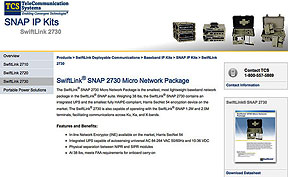TeleCommunication Systems, Inc. (TCS) (NASDAQ: TSYS) has received an additional $12.8 million in funding from the U.S. Army for equipment and field services support of Secret Internet Protocol Router and Non-secure Internet Protocol Router Access Point (SNAP) Very Small Aperture Terminal (VSAT) satellite systems. These awards are the result of exercised options on five existing delivery orders issued by the U.S. Army Communications - Electronics Life Cycle Management Command.
This additional SNAP funding will provide equipment and support for TCS' highly reliable SwiftLink® deployable communications products. The U.S. Army
The TCS SwiftLink VSAT systems used to fulfill SNAP program requirements provide multimedia communications capabilities which convey encrypted voice, video and data. TCS SwiftLink products are highly transportable and ruggedized, and have a graphical user interface that facilitates easy set-up and operation. The modularity and plug-and-play interfaces between all radio frequency (RF) and baseband configurations inherent in the SwiftLink product line result in communication solutions tailored to the end-user's specific needs.


